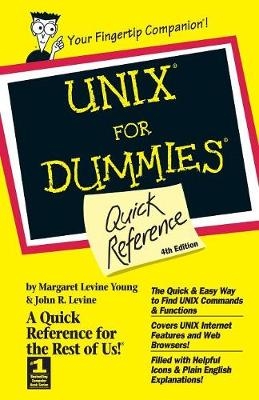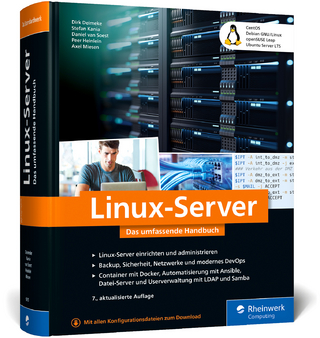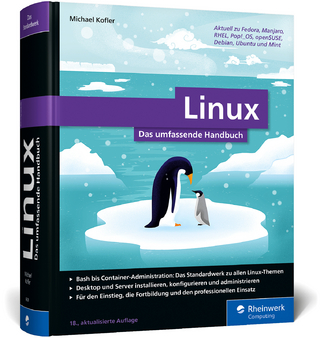
UNIX For Dummies Quick Reference
For Dummies (Verlag)
978-0-7645-0420-4 (ISBN)
Get instant access to the UNIX commands and functions you need with this fast and friendly reference guide to all things UNIX. UNIX For Dummies Quick Reference, 4th Edition, clues you in to the most popular and essential parts of UNIX: X Windows managers, text editors, sending and receiving electronic mail, and networking.
Starting with the UNIX shell and moving steadily deeper inside the UNIX environment, UNIX For Dummies Quick Reference, 4th Edition, cuts to the chase with clear, concise answers to all your UNIX questions. From the basics of entering commands, organizing files and directories, and determining which shell you're using, this valuable little reference book steers you in the right direction. More than 100 basic UNIX commands are alphabetically sorted for easy lookups, and advanced topics on X Windows managers, text editors, and online components are all just a few pages away.
Why bother with the hassles of sorting through thousands of pages of text when the answers you need are all right here, tucked inside a lay-flat binding that lets you keep your book open to the page you're reading. Could using a UNIX reference be any easier?
Unlike her peers in that 40-something bracket, Margaret Levine Young was exposed to computers at an early age. In high school, she got into a computer club known as the R.E.S.I.S.T.O.R.S., a group of kids who spent Saturdays in a barn fooling around with three antiquated computers. She stayed in the field through college against her better judgment and despite her brother John's presence as a graduate student in the computer science department. Margy graduated from Yale and went on to become one of the first microcomputer managers in the early 1980s at Columbia Pictures, where she rode the elevator with big stars whose names she wouldn't dream of dropping here. Since then, Margy (www.gurus.com/margy) has coauthored more than 20 computer books about the topics of the Internet, UNIX, WordPerfect, Microsoft Access, and (stab from the past) PC-File and Javelin, including The Internet For Dummies, 6th Edition, and WordPerfect 7 For Windows 95 For Dummies (all from IDG Books Worldwide, Inc.). She loves her husband, Jordan; her kids, Meg and Zac; gardening; chickens; reading; and anything to do with eating. Margy and her husband also run Great Tapes for Kids (www.greattapes.com) from their home in the middle of a cornfield near Middlebury, Vermont. John R. Levine was a member of the same computer club Margy was in -- before high school students, or even high schools, had computers. He wrote his first program in 1967 on an IBM 1130 (a computer almost as fast as your modern digital wristwatch, only more difficult to use). He became an official system administrator of a networked computer at Yale in 1975 and has been working in the computer and network biz since 1977. He got his company on to Usenet (see Part IV) early enough that it appears in a 1982 Byte magazine article in a map of Usenet, which then was so small that the map fit on half a page. He used to spend most of his time writing software, although now he mostly writes books (including UNIX For Dummies and Internet Secrets, both from IDG Books Worldwide, Inc.) because it's more fun and he can do so at home in the hamlet of Trumansburg, New York, where he holds the exalted rank of sewer commissioner and offers free samples to visitors and plays with his young daughter when he's supposed to be writing. He also does a fair amount of public speaking. (See www.iecc.com/johnl.) He holds a B.A. and a Ph.D. in computer science from Yale University, but please don't hold that against him.
Introduction: How to Use This Book 1
What’s in This Book 2
Conventions Used in This Book 2
The Cast of Icons 3
Write to Us! 3
Part I: Commanding UNIX Using the Shell 5
Directories 6
Environment Variables 6
Filenames 7
Help with Commands 7
Identifying Your Shell 8
Pathnames 8
Quoting Characters on the Command Line 9
Redirecting with Pipes and Filters 9
Shell Prompts 10
Special Characters and What They Do 11
Startup Files 13
Typing Commands 13
Wildcards 14
Part II: UNIX Commands 15
alias 16
at 16
awk 18
bash 18
bc 19
bg 20
cal 20
calendar 21
cancel 22
cat 22
cd 23
chgrp 24
chmod 25
chown 26
clear 26
cmp 27
compress 27
cp 28
cpio 29
crontab 31
csh 32
date 33
df 34
diff 34
diff3 36
dircmp 36
du 37
echo 38
ed 38
elm 39
emacs 39
env 39
ex 39
exit 39
fg 40
file 41
find 42
finger 44
ftp 45
grep 45
gunzip 47
gzip 48
head 49
help 49
history 50
id 51
irc 51
jobs 51
kill 52
ksh 53
ln 53
lp 55
lpq 57
lpr 57
lprm 58
lpstat 59
ls 60
lynx 62
mail 62
man 62
mesg 63
mkdir 64
more 64
mv 65
nice 67
nn 67
pack 68
passwd 68
pico 69
pine 69
pr 69
ps 71
pwd 73
rcp 73
red 73
rehash 73
rlogin 74
rm 74
rmdir 75
rn 76
rsh 76
script 76
sdiff 77
sed 77
set 78
setenv 79
sh 80
sleep 81
sort 82
spell 83
stty 84
tail 85
talk 86
tar 86
tee 88
telnet 89
time 89
tin 89
touch 90
trn 90
troff 91
tty 92
umask 92
unalias 93
uname 94
uncompress 95
uniq 95
unpack 96
uucp 97
uudecode 98
uuencode 99
vacation 100
vi 100
wall 100
wc 101
who 102
write 102
zcat 103
Part III: Using X Window Managers 105
Anatomy of a Window 106
Changing the Window Size 106
Exiting the Window Manager 107
Keyboard Shortcuts 108
Motif 108
FVWM 108
Maximizing a Window 109
Minimizing (Iconifying) a Window 109
Moving a Window 110
Opening a Window in an Obsolete but Easy Way 110
Opening Windows in a User-Friendly Way 110
Restoring a Window 111
Restoring a Window from an Icon 111
Selecting Several Things with Your Mouse 111
Switching Windows 112
The Window Menu 112
Working with the Common Desktop Environment (CDE) 114
CDE Applications 114
CDE Windows 115
The Front Panel 115
Front Panel Subpanels 116
Part IV: Using Text Editors 119
Using the ed Text Editor 120
Starting ed 120
Getting out of ed 120
ed commands 120
Using the emacs Text Editor 122
Starting emacs 122
Getting out of emacs 122
emacs commands 122
emacs commands for editing multiple files 124
Using the pico Text Editor 124
Starting pico 125
Getting out of pico 125
pico commands 125
Using the VI Text Editor 126
Starting VI 126
Getting Out of VI 127
vi Commands 127
vi Commands in Input Mode 130
Part V: Sending and Receiving Electronic Mail 131
Addressing Your Mail 132
elm 132
Sending a message 132
Reading your messages 133
Printing a message 133
Saving a message 134
Exiting the program 134
Changing your elm options 134
Getting help 135
Command line options 135
Mail 136
Sending a message 136
Reading your messages 137
Forwarding a message 137
Printing a message 138
Saving a message 138
Exiting the mail program 138
Command line options 138
Pine 139
Sending a message 139
Reading your messages 140
Replying to a message 141
Forwarding a message 141
Printing a message 141
Saving a message 142
Deleting a message 142
Adding an address to an address book 143
Retrieving an address from an address book 143
Exiting the program 143
Changing options 144
Getting help 144
Sending Mail Using Other Mail Programs 144
Part VI: Connecting to Other Computers 147
FTP 148
Connecting to a remote system 148
Connecting by using anonymous FTP 148
Quitting FTP 149
Listing the files in a directory 149
Moving to other directories 150
Retrieving files 150
Retrieving groups of files 151
Decompressing files that you have retrieved 151
Downloading retrieved files to your PC 152
Sending files to a remote system using FTP 153
Summary of FTP commands 154
IRC: Chatting with Others on the Net 154
Starting IRC 155
Finding IRC channels 155
Joining an IRC channel 156
Quitting IRC 156
Getting help with IRC commands 156
Chatting by using IRC commands 156
Summary of IRC commands 157
Having an IRC private conversation 158
rcp 158
Copying files from a remote computer 158
Copying all the files in a directory 159
rlogin and rsh 159
Connecting to a remote computer 159
Disconnecting from a remote computer 160
Running commands on a remote computer by using rsh 160
Logging in automatically by using rlogin and rsh 161
telnet 162
Connecting to a remote computer 162
Disconnecting from a remote computer 162
Part VII: Finding Resources on the Net 163
Internet Explorer 164
Lynx 164
Going directly to a page 164
Going back to a previous page 165
Searching within Web pages 165
Key summary 165
Netscape 166
Starting up 166
Going to a new page 166
Going back to a previous page 167
Finding places to go in Netscape 167
Printing a page 167
Saving a file 168
Freeing disk space 168
Quitting Netscape 168
Resource Indexes 168
Part VIII: Usenet Newsgroups 171
Netiquette: Avoiding Getting Flamed 172
Reading Usenet Newgroups with trn 172
Starting your newsreader 172
Changing the order in which newsgroups appear 174
Choosing which new newsgroups to subscribe to 174
Dealing with rot-13 articles 175
Dealing with shar files 175
Dealing with uuencoded files 175
Exiting the newsreader 176
Finding articles on specific topics 176
Finding a newsgroup 177
Getting help 177
Posting a new article 178
Reading articles 179
Replying to and following up an article 180
Sending an e-mail reply 181
Posting a news follow-up 181
Saving an article 181
Selecting newsgroups to read 182
Selecting the threads that you want to read 182
Skipping over a newsgroup 184
Skipping an uninteresting or offensive article 184
Skipping unread articles 184
Unsubscribing to a newsgroup 185
Understanding Newsgroup Names 185
Glossary: Techie Talk 187
Index 201
| Erscheint lt. Verlag | 1.9.1998 |
|---|---|
| Sprache | englisch |
| Maße | 147 x 216 mm |
| Gewicht | 236 g |
| Themenwelt | Informatik ► Betriebssysteme / Server ► Unix / Linux |
| ISBN-10 | 0-7645-0420-7 / 0764504207 |
| ISBN-13 | 978-0-7645-0420-4 / 9780764504204 |
| Zustand | Neuware |
| Haben Sie eine Frage zum Produkt? |
aus dem Bereich


